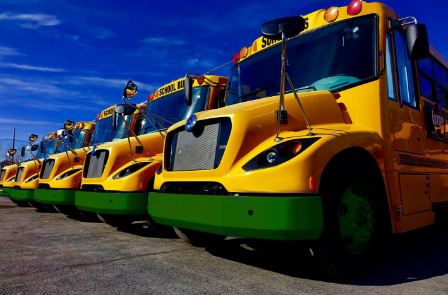A new program funded by proceeds from California’s cap-and-trade program aims to encourage the turnover of the state’s school bus fleet to zero-emission and cleaner-burning school buses.
The program, known as The Rural School Bus Pilot Project, is a partnership between the North Coast Unified Air Quality Management District (AQMD) and the California Air Resources Board (CARB).
As reported, the North Coast Unified AQMD will administer the $10 million funding for this statewide school bus project.
School districts throughout the state have been alerted that applications for grant funding will be accepted from March 1 through March 30. All California public schools and California public entities that own school buses are eligible to apply.
“This pilot project will help smaller school districts get rid of older, dirty school buses and replace them with ultra-clean and zero-emission models,” says CARB Chair Mary D. Nichols. “Thanks to funds from the sale of the state’s share of cap-and-trade allowances, school children will not only be helping to fight global warming, they will also be breathing less smog and cancer-causing air pollution.”
CARB says funding is available for the purchase of new advanced technology zero-emission fuel cell and battery-electric school buses and associated vehicle charging equipment. Near-zero-emission plug-in hybrid school buses, or new school buses that operate on renewable fuels, including renewable diesel, natural gas and propane, are also eligible.
Applications will be ranked first by the size of the air district, then by age of the school bus, and finally by total mileage on the school bus. School districts in small air districts will have first priority for the funding, but all school districts are encouraged to apply.
The project could fund as many as 60 new school buses statewide, reducing roughly 10,000 metric tons of greenhouse-gas emissions. These newer and cleaner school buses also reduce fine particle pollution and toxic air contaminants.
The Rural School Bus Pilot Project is part of California Climate Investments, a statewide program that puts billions of cap-and-trade dollars to work reducing greenhouse-gas emissions, strengthening the economy, and improving public health and the environment – particularly in disadvantaged communities.
The cap-and-trade program also creates a financial incentive for industries to invest in clean technologies and develop innovative ways to reduce pollution. California Climate Investments projects include affordable housing, renewable energy, public transportation, zero-emission vehicles, environmental restoration, more sustainable agriculture, recycling and much more. At least 35% of these investments are made in disadvantaged and low-income communities.
An informational online webinar for applicants is set for 10 a.m. on Feb. 16.





